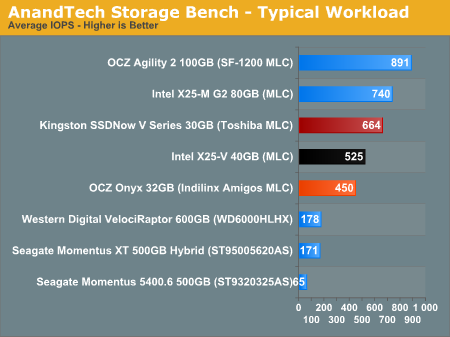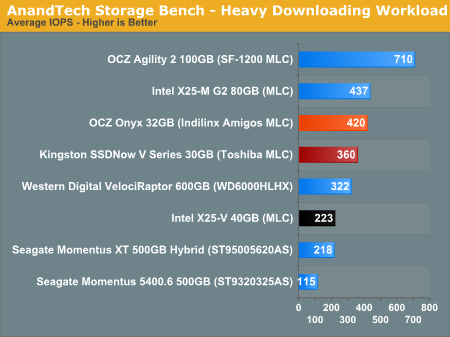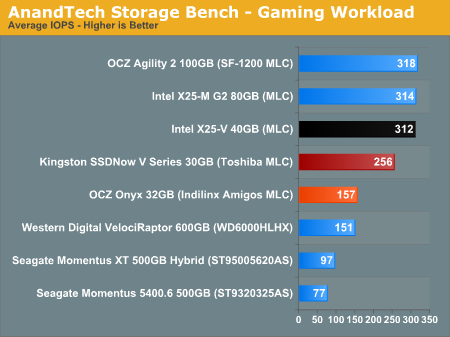2010 Value SSD (~$100) Roundup: Kingston and OCZ take on Intel
by Anand Lal Shimpi on June 3, 2010 12:01 AM ESTAnandTech Storage Bench
The first in our benchmark suite is a light usage case. The Windows 7 system is loaded with Firefox, Office 2007 and Adobe Reader among other applications. With Firefox we browse web pages like Facebook, AnandTech, Digg and other sites. Outlook is also running and we use it to check emails, create and send a message with a PDF attachment. Adobe Reader is used to view some PDFs. Excel 2007 is used to create a spreadsheet, graphs and save the document. The same goes for Word 2007. We open and step through a presentation in PowerPoint 2007 received as an email attachment before saving it to the desktop. Finally we watch a bit of a Firefly episode in Windows Media Player 11.
There’s some level of multitasking going on here but it’s not unreasonable by any means. Generally the application tasks proceed linearly, with the exception of things like web browsing which may happen in between one of the other tasks.
The recording is played back on all of our drives here today. Remember that we’re isolating disk performance, all we’re doing is playing back every single disk access that happened in that ~5 minute period of usage. The light workload is composed of 37,501 reads and 20,268 writes. Over 30% of the IOs are 4KB, 11% are 16KB, 22% are 32KB and approximately 13% are 64KB in size. Less than 30% of the operations are absolutely sequential in nature. Average queue depth is 6.09 IOs.
The performance results are reported in average I/O Operations per Second (IOPS):

Our storage suite puts more emphasis on sequential transfers than PCMark Vantage and thus Kingston gets the performance advantage here in our typical/light workload case. It's a very realistic workload and one that gives Kingston the overall advantage.
If there’s a light usage case there’s bound to be a heavy one. In this test we have Microsoft Security Essentials running in the background with real time virus scanning enabled. We also perform a quick scan in the middle of the test. Firefox, Outlook, Excel, Word and Powerpoint are all used the same as they were in the light test. We add Photoshop CS4 to the mix, opening a bunch of 12MP images, editing them, then saving them as highly compressed JPGs for web publishing. Windows 7’s picture viewer is used to view a bunch of pictures on the hard drive. We use 7-zip to create and extract .7z archives. Downloading is also prominently featured in our heavy test; we download large files from the Internet during portions of the benchmark, as well as use uTorrent to grab a couple of torrents. Some of the applications in use are installed during the benchmark, Windows updates are also installed. Towards the end of the test we launch World of Warcraft, play for a few minutes, then delete the folder. This test also takes into account all of the disk accesses that happen while the OS is booting.
The benchmark is 22 minutes long and it consists of 128,895 read operations and 72,411 write operations. Roughly 44% of all IOs were sequential. Approximately 30% of all accesses were 4KB in size, 12% were 16KB in size, 14% were 32KB and 20% were 64KB. Average queue depth was 3.59.

Our heavy workload is much more of a sequential write test and that's where Intel really falls short. Here OCZ's Onyx takes the cake as it offers the best sequential write speed out of the value drives.
The gaming workload is made up of 75,206 read operations and only 4,592 write operations. Only 20% of the accesses are 4KB in size, nearly 40% are 64KB and 20% are 32KB. A whopping 69% of the IOs are sequential, meaning this is predominantly a sequential read benchmark. The average queue depth is 7.76 IOs.

If you're mostly reading large amounts of data from your drive the X25-V and Kingston SSDNow V Series are your best bet. You won't be able to do much in the way of gaming on these tiny drives but any similar workloads should see results like these.










49 Comments
View All Comments
cknobman - Thursday, June 3, 2010 - link
Your reviews always show a breakdown of how a drive performs before and after TRIM. How are you issuing the TRIM command? I thought by default Windows 7 always issued the TRIM command on every operation as long as your drive supported it.gaspard - Sunday, June 6, 2010 - link
well you can disable it via Windows' fsutil command: fsutil behavior query DisableDeleteNotify NO TRIM: fsutil behavior set DisableDeleteNotify 1 TRIM ON: fsutil behavior set DisableDeleteNotify 0GullLars - Thursday, June 3, 2010 - link
I've been waiting for an article like this for a few months now, and you did a good job Anand, as always ;)I have a couple of questions:
Why not include OCZ Agility 30GB? ($119 @ newegg)
Why only test random write and not read at QD 32?
There is little difference in random writes, but random reads double for the x25-V, and i'd guess increase a bit for the Onyx too.
A full Barefoot drive can do 60MB/s random read @ QD 5.
x25-V can do about 70MB/s @ QD 4, and about 100MB/s @ QD 8 for random reads.
Why not include PCmark Vantage HDD subscores?
They are made to showcase the strong and weak points of storage performance, and are relevant to what drive to pick. The total HDD score can be the same for two drives with completely different strenghts.
Dylock - Thursday, June 3, 2010 - link
The OCZ Agility 60GB is on sale at Amazon.com for 144$, as of today. That's $2.4 per GB.An Indilix controller to boot. The lower grade memory comes into play for performance , but not by much.
Movieman420 - Thursday, June 3, 2010 - link
Currently a 30gb Vertex is $109 ($99 after rebate)! Instead the Onyx was used which uses 'half' of an Idilinx controller (Indilinx Amigo). I know you had an Onyx handy cuz of recent testing but really. Even tho the Vertex is 'old gear', it woulda blew the doors off the other drives in your testing.u.of.ipod - Thursday, June 3, 2010 - link
I want a SSD for my HTPC. Hopefully it can be shutdown and booted up more quickly, be more responsive in Windows Media Center 7 and finally to provide space for a second 3.5" storage drive. Is one of these value drives for me? Should I just choose a 2.5" mechanical drive instead?kmmatney - Friday, June 4, 2010 - link
The Intel 40 GB SSD works fine on Windows XP without TRIM. Just install the Intel SSD Toolbox, and it will perform a "TRIM" or garbage collection routine automatically, once a week.kmmatney - Friday, June 4, 2010 - link
Whoops - was supposed to be a new comment, and not a "reply"...gaspard - Sunday, June 6, 2010 - link
whichever one you like, and NO... those are the answers respectivelymrmike_49 - Saturday, June 5, 2010 - link
I'd like to see tests of loading times for various games, start-up as well as level loads. Games are an ideal use for SSDs, many many Reads, very few Writes. A $100 SSD that could triple my load speed (or more) would be nice.How about redoing this review, concentrating on actual load start-up times and level loads of popular games??!!